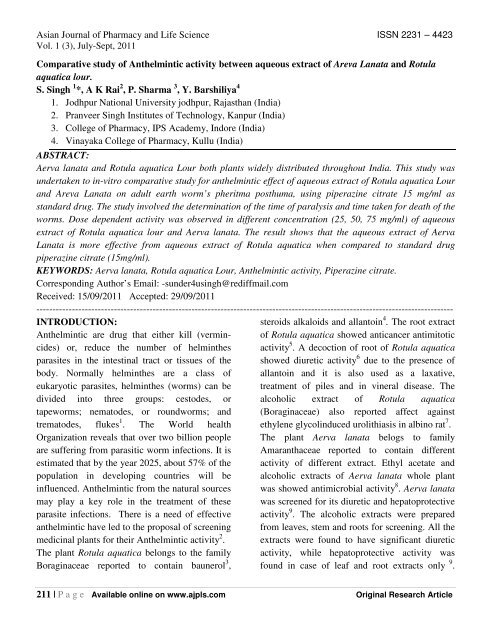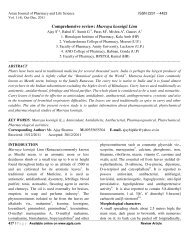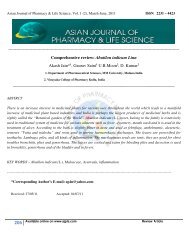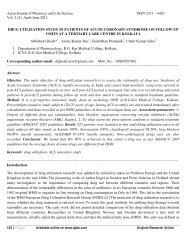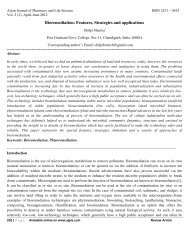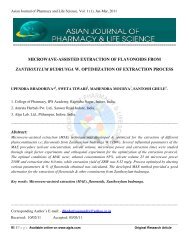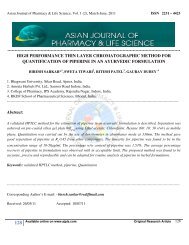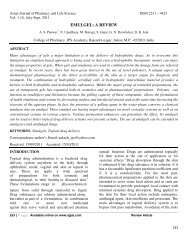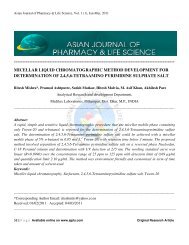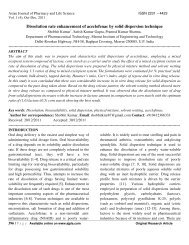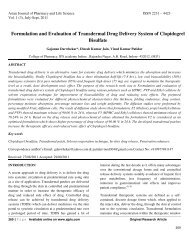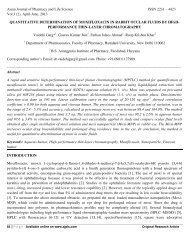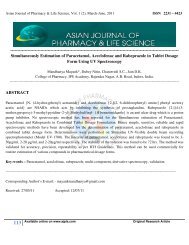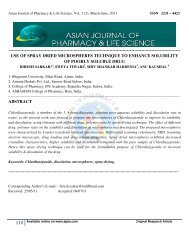(3), July-Sept, 2011 Comparative study of Anthelmintic
(3), July-Sept, 2011 Comparative study of Anthelmintic
(3), July-Sept, 2011 Comparative study of Anthelmintic
You also want an ePaper? Increase the reach of your titles
YUMPU automatically turns print PDFs into web optimized ePapers that Google loves.
Asian Journal <strong>of</strong> Pharmacy and Life Science ISSN 2231 – 4423<br />
Vol. 1 (3), <strong>July</strong>-<strong>Sept</strong>, <strong>2011</strong><br />
<strong>Comparative</strong> <strong>study</strong> <strong>of</strong> <strong>Anthelmintic</strong> activity between aqueous extract <strong>of</strong> Areva Lanata and Rotula<br />
aquatica lour.<br />
S. Singh 1 *, A K Rai 2 , P. Sharma 3 , Y. Barshiliya 4<br />
1. Jodhpur National University jodhpur, Rajasthan (India)<br />
2. Pranveer Singh Institutes <strong>of</strong> Technology, Kanpur (India)<br />
3. College <strong>of</strong> Pharmacy, IPS Academy, Indore (India)<br />
4. Vinayaka College <strong>of</strong> Pharmacy, Kullu (India)<br />
ABSTRACT:<br />
Aerva lanata and Rotula aquatica Lour both plants widely distributed throughout India. This <strong>study</strong> was<br />
undertaken to in-vitro comparative <strong>study</strong> for anthelmintic effect <strong>of</strong> aqueous extract <strong>of</strong> Rotula aquatica Lour<br />
and Areva Lanata on adult earth worm’s pheritma posthuma, using piperazine citrate 15 mg/ml as<br />
standard drug. The <strong>study</strong> involved the determination <strong>of</strong> the time <strong>of</strong> paralysis and time taken for death <strong>of</strong> the<br />
worms. Dose dependent activity was observed in different concentration (25, 50, 75 mg/ml) <strong>of</strong> aqueous<br />
extract <strong>of</strong> Rotula aquatica lour and Aerva lanata. The result shows that the aqueous extract <strong>of</strong> Aerva<br />
Lanata is more effective from aqueous extract <strong>of</strong> Rotula aquatica when compared to standard drug<br />
piperazine citrate (15mg/ml).<br />
KEYWORDS: Aerva lanata, Rotula aquatica Lour, <strong>Anthelmintic</strong> activity, Piperazine citrate.<br />
Corresponding Author’s Email: -sunder4usingh@rediffmail.com<br />
Received: 15/09/<strong>2011</strong> Accepted: 29/09/<strong>2011</strong><br />
---------------------------------------------------------------------------------------------------------------------------------<br />
INTRODUCTION:<br />
<strong>Anthelmintic</strong> are drug that either kill (vermincides)<br />
or, reduce the number <strong>of</strong> helminthes<br />
parasites in the intestinal tract or tissues <strong>of</strong> the<br />
body. Normally helminthes are a class <strong>of</strong><br />
eukaryotic parasites, helminthes (worms) can be<br />
divided into three groups: cestodes, or<br />
tapeworms; nematodes, or roundworms; and<br />
trematodes, flukes 1 . The World health<br />
Organization reveals that over two billion people<br />
are suffering from parasitic worm infections. It is<br />
estimated that by the year 2025, about 57% <strong>of</strong> the<br />
population in developing countries will be<br />
influenced. <strong>Anthelmintic</strong> from the natural sources<br />
may play a key role in the treatment <strong>of</strong> these<br />
parasite infections. There is a need <strong>of</strong> effective<br />
anthelmintic have led to the proposal <strong>of</strong> screening<br />
medicinal plants for their <strong>Anthelmintic</strong> activity 2 .<br />
The plant Rotula aquatica belongs to the family<br />
Boraginaceae reported to contain baunerol 3 ,<br />
steroids alkaloids and allantoin 4 . The root extract<br />
<strong>of</strong> Rotula aquatica showed anticancer antimitotic<br />
activity 5 . A decoction <strong>of</strong> root <strong>of</strong> Rotula aquatica<br />
showed diuretic activity 6 due to the presence <strong>of</strong><br />
allantoin and it is also used as a laxative,<br />
treatment <strong>of</strong> piles and in vineral disease. The<br />
alcoholic extract <strong>of</strong> Rotula aquatica<br />
(Boraginaceae) also reported affect against<br />
ethylene glycolinduced urolithiasis in albino rat 7 .<br />
The plant Aerva lanata belogs to family<br />
Amaranthaceae reported to contain different<br />
activity <strong>of</strong> different extract. Ethyl acetate and<br />
alcoholic extracts <strong>of</strong> Aerva lanata whole plant<br />
was showed antimicrobial activity 8 . Aerva lanata<br />
was screened for its diuretic and hepatoprotective<br />
activity 9 . The alcoholic extracts were prepared<br />
from leaves, stem and roots for screening. All the<br />
extracts were found to have significant diuretic<br />
activity, while hepatoprotective activity was<br />
found in case <strong>of</strong> leaf and root extracts only 9 .<br />
211 | P a g e Available online on www.ajpls.com Original Research Article
Asian Journal <strong>of</strong> Pharmacy and Life Science ISSN 2231 – 4423<br />
Vol. 1 (3), <strong>July</strong>-<strong>Sept</strong>, <strong>2011</strong><br />
Areva lanata also reprted to contain antiinflammatory<br />
activity 10 and antidiabetic activity<br />
11 .<br />
Literature survey reveals that there are no reports<br />
on comparative <strong>study</strong> on aqueous extract for<br />
anthelmintic activity. Hence, this lead us to<br />
comparative <strong>study</strong> for anthelmintic activity <strong>of</strong><br />
aqueous extract <strong>of</strong> Rotula aquatica and Aerva<br />
lanata.<br />
MATERIALS AND METHODOLOGY:<br />
Plant Material:<br />
Root <strong>of</strong> Rotula aquatica lour and Aerva lanata<br />
was collected and authenticated by Dr. S. N.<br />
Dwivedi, Head <strong>of</strong> the department <strong>of</strong> botany<br />
Janata Post Graduate College A. P. S. University<br />
Rewa-486002 M. P. India. The whole plant is<br />
then dried, powdered and stored in airtight<br />
containers for further use.<br />
Drug and chemicals:<br />
The drug piperazine citrate purchased from<br />
commercial sources and all other chemicals<br />
were <strong>of</strong> analytical grade.<br />
Preparation <strong>of</strong> Extract:<br />
The powdered material <strong>of</strong> both crude drugs was<br />
subjected to soxhlet extraction with various<br />
solvents ranging from non-polar to polar. The<br />
solvents used were Petroleum ether, benzene,<br />
chlor<strong>of</strong>orm, alcohol and then both <strong>of</strong> powdered<br />
drugs macerated with distilled water. Each time<br />
before extraction with next solvents the marc was<br />
air-dried. All the extracts were concentrated by<br />
distilling the solvent at low temperature. They<br />
were then weighed and percentages <strong>of</strong> different<br />
extractive values were calculated with respect to<br />
air-dried substance.<br />
500 ml <strong>of</strong> distilled water for 24 hours during<br />
successive extraction. The extract was double<br />
filtered by using muslin cloth and whatman filter<br />
paper no. 1 and the extract concentrated then<br />
dried on water bath. Then different concentration<br />
<strong>of</strong> aqueous extract (25, 50,75mg/ml) were<br />
prepared for further <strong>study</strong>.<br />
Phytochemical procedure:<br />
The preliminary phytochemical screening <strong>of</strong><br />
Rotula aquatica lour and Aerva Lanata was<br />
carried out in order to ascertain the presence <strong>of</strong> its<br />
constituents by utilizing standard conventional<br />
protocols.<br />
<strong>Anthelmintic</strong> activity:<br />
<strong>Anthelmintic</strong> activity was carried as per the<br />
method reported by Bimlesh Kumar et al 2 with<br />
minor modifications. The assay was performed<br />
on adult Indian earth worm Pheritima posthuma<br />
due to its anatomical and physiological<br />
resemblance with the intestinal round worm<br />
parasite <strong>of</strong> human beings. Different<br />
concentrations <strong>of</strong> each aqueous extract (25, 50,75<br />
mg/ ml in normal saline) were prepared and six<br />
worms were placed in it. All the extracts and the<br />
standard drug solution were freshly prepared<br />
before starting the experiments. Mean time for<br />
paralysis (in min) was noted when no movement<br />
<strong>of</strong> any sort could be observed except when the<br />
worm was shaken vigorously; time for death <strong>of</strong><br />
worms (in min) was recorded after ascertaining<br />
that worms neither moved when shaken<br />
vigorously nor when dipped in warm water<br />
(50°C). Piperazine citrate (15 mg/ml) was used as<br />
reference standard.<br />
Aqueous Extract (maceration method):<br />
Powdered material <strong>of</strong> the root <strong>of</strong> Rotula aquatica<br />
and Aerva lanata was kept for maceration with<br />
212 | P a g e Available online on www.ajpls.com Original Research Article
Asian Journal <strong>of</strong> Pharmacy and Life Science ISSN 2231 – 4423<br />
Vol. 1 (3), <strong>July</strong>-<strong>Sept</strong>, <strong>2011</strong><br />
Table: 1 <strong>Anthelmintic</strong> activity <strong>of</strong> aqueous extract <strong>of</strong> Rotula aquatica and Aerva lanata<br />
Treatment Concentration used Time taken for Paralysis<br />
(min)<br />
Time taken for death<br />
(min)<br />
Piperazine citrate 15 mg/ml 15.18± 0.1641 26.95±0.1565<br />
Aqueous extract <strong>of</strong> 25 mg/ml 28.60± 0.2989 36.98±0.3763<br />
Rotula aquatica 50 mg/ml 21.02± 0.2286 30.35±0.4403<br />
75 mg/ml 16.95± 0.3575 22.33± 0.5445<br />
Aqueous extract <strong>of</strong> 25 mg/ml 26.17 ±0.4341 34.63±0.3528<br />
Aerva Lanata<br />
50 mg/ml 18.30±0.2503 29.38±0.4277<br />
75 mg/ml 12.23±0.3084 16.32±0.4175<br />
Value are expressed as mean ± SEM (n=6)<br />
Figure: 1 <strong>Anthelmintic</strong> activity <strong>of</strong> aqueous extract <strong>of</strong> Rotula aquatica and Aerva Lanata.<br />
Group I- Control (Normal saline), Group-II Standard (Piperazine citrate), Group-III Aqueous Extract <strong>of</strong><br />
Rotula aquatica (AQERA 25 mg/ml), Group-IV Aqueous Extract <strong>of</strong> Rotula aquatica (AQERA 50 mg/ml),<br />
Group-V Aqueous Extract <strong>of</strong> Rotula aquatica (AQERA 75 mg/ml), Group-VI Aqueous Extract <strong>of</strong> Aerva<br />
lanata (AQEAL 25 mg/ml), Group-VII Aqueous Extract <strong>of</strong> Aerva lanata (AQEAL 50 mg/ml), Group-VIII<br />
Aqueous Extract <strong>of</strong> Aerva lanata (AQEAL 75 mg/ml).<br />
RESULT AND DISCUSSION:<br />
Preliminary phytochemical screening studies on<br />
Rotula aquatica and Aerva lanata revealed the<br />
presence <strong>of</strong> carbohydrate, tannins and flavonoids.<br />
Some <strong>of</strong> these phytoconstituents may be<br />
responsible for anthelmintic activity. The result<br />
shows that the aqueous extract <strong>of</strong> Aerva lanata<br />
showed more potent anthelmintic activity from<br />
213 | P a g e Available online on www.ajpls.com Original Research Article
Asian Journal <strong>of</strong> Pharmacy and Life Science ISSN 2231 – 4423<br />
Vol. 1 (3), <strong>July</strong>-<strong>Sept</strong>, <strong>2011</strong><br />
aqueous extract <strong>of</strong> Rotula aquatica when<br />
compared to standard drug (Table:1and Figure:1).<br />
At the concentration <strong>of</strong> 75 mg/ml both the<br />
aqueous extract showed effective activity as<br />
compared to the standard drug. In case aqueous<br />
extract <strong>of</strong> Rotula aquatica at concentration <strong>of</strong> 75<br />
mg/ ml caused paralysis in 16.95 min and death<br />
in 22.33 min, while at concentration 50 mg/ml<br />
extract showed paralysis in 21.02 min and death<br />
in 30.35 min and concentration 25mg/ml showed<br />
paralysis in 28.60 min and death in 36.98 min<br />
against Pheritima postuma.<br />
In case <strong>of</strong> Areva lanata 75mg/ml showed<br />
paralysis in 12.23 min and death in 16.32 min,<br />
while the reference drug piperazine citrate<br />
15mg/ml showed the paralysis in 15.18 min and<br />
death in 26.95 min. The predominant effect <strong>of</strong><br />
piperazine citrate on the worm is to cause a<br />
flaccid paralysis that result in expulsion <strong>of</strong> the<br />
worm by peristalsis.<br />
Finally result reveals that the aqueous extract <strong>of</strong><br />
Aerva lanata found more effective from aqueous<br />
extract <strong>of</strong> Rotula aquatica at different<br />
concentration against helminth.<br />
CONCLUSION:<br />
In conclusion, the data (Table: 1 and Figure: 1)<br />
reveals that aqueous extract <strong>of</strong> Aerva lanata at<br />
different concentration was more effective from<br />
the other aqueous extract <strong>of</strong> Rotula aquatica<br />
against Pheritma postuma. Further studies are<br />
necessary to isolate the active compound in the<br />
crude extract <strong>of</strong> Aerva lanata which is<br />
responsible for activity.<br />
REFRENCES:<br />
1. Akash Jain, Akhilesh Rawal,<br />
“<strong>Comparative</strong> <strong>study</strong> <strong>of</strong> <strong>Anthelmintic</strong><br />
Activity <strong>of</strong> Different Extract <strong>of</strong><br />
Catharanthus roseus”, journal <strong>of</strong><br />
pharmaceutical research and opininion,<br />
June <strong>2011</strong>, 1(1): 23-24.<br />
2. Bimlesh Kumar et. Al. “<strong>Comparative</strong><br />
<strong>Anthelmintic</strong> Activity <strong>of</strong> Aqueous and<br />
Ethanolic Leaf Extracts Of Clitoria<br />
Ternatea”, Int. J. Drug Dev. & Res., Jan-<br />
March <strong>2011</strong>,3(1): 62-69.<br />
3. Rastogi RP, Mehrotra BN. Compendium<br />
<strong>of</strong> Indian Medicinal Plant. Vol-1 New<br />
Delhi: National institute <strong>of</strong> science<br />
Communication: 1959.<br />
4. Patil S, Jolly CI, Narayanan S. “Free<br />
radical scavenging activity <strong>of</strong> acacia<br />
catechu and Rotula aquatica”, Indian<br />
drug 40(6), 2003, 328-332.<br />
5. Patil S, Jolly CI, Narayanan S.<br />
“Evaluation <strong>of</strong> Antimitotic activity <strong>of</strong> the<br />
root <strong>of</strong> Rotula aquatica(lour): A<br />
traditional herb used in the treatment <strong>of</strong><br />
cancer”, Indian Journal <strong>of</strong> experimental<br />
biology. 42, 2004, 893-899.<br />
6. Gilhotra Umesh Kr., Christina A.J.M.<br />
“Effect <strong>of</strong> Rotula aquatica Lour. on<br />
ethylene-glycol induced urolithiasis in<br />
rats”, International Journal <strong>of</strong> Drug<br />
Development & Research. Jan-March<br />
<strong>2011</strong> 3(1):273-280.<br />
7. Reddy GBS, Sriniwasan KK. “An<br />
experimental evaluation <strong>of</strong> root <strong>of</strong> Rotula<br />
aquatica for antiurolithiatic activity in<br />
albino rats” Indian drugs. 30(8), 2000,<br />
398-404.<br />
8. Chowdhury D, Sayeed A, Islam A, Shah<br />
ABM, Astaq MKGR. “Antimicrobial<br />
activity and cytotoxicity <strong>of</strong> Aerva lanata”,<br />
Fitoterapia 2002; 73(1):92-4.<br />
9. Majumdar FI, Shah MB, Patel KN, Shah<br />
BK. Aerva lanata-Its diuretic and<br />
hepatoprotective activity, Indian J. Nat.<br />
Prod 1999; 15(1):9-12.<br />
10. Vtrichelvan T, Jegadeesan M, Senthil PM,<br />
Murali NP, Saikumar K. “Diuretic and<br />
214 | P a g e Available online on www.ajpls.com Original Research Article
Asian Journal <strong>of</strong> Pharmacy and Life Science ISSN 2231 – 4423<br />
Vol. 1 (3), <strong>July</strong>-<strong>Sept</strong>, <strong>2011</strong><br />
anti-inflammatory activities <strong>of</strong> Aerva<br />
lanata in rats”. Indian Journal <strong>of</strong><br />
Pharmaceutical Sciences 2000; 62(4):300-<br />
302.<br />
11. Vetrichelvan T, Jegadeesan M. “Antidiabetic<br />
activity <strong>of</strong> alcoholic extract <strong>of</strong><br />
Aerva lanata (L) Juss. Ex Schultes in<br />
rats”, J Ethnopharmacol 2002; 80(2-<br />
3):103-7.<br />
12. Rajesh R, Chitra K, Padmaa M. Paarakh.<br />
“In vitro <strong>Anthelmintic</strong> Activity <strong>of</strong> Aerial<br />
Parts <strong>of</strong> Aerva lanata Linn Juss”,<br />
International Journal <strong>of</strong> Pharmaceutical<br />
Sciences and Drug Research 2010; 2(4):<br />
269-271<br />
13. C.H. Chandrashekhar, K P. Latha, H.M.<br />
Vagdevi, V. P. Vaidya. “<strong>Anthelmintic</strong> <strong>of</strong><br />
activity <strong>of</strong> the crude extract <strong>of</strong> Ficus<br />
racemosa”,International journal <strong>of</strong> Green<br />
Pharmacy April-June 2008; 100-103.<br />
14. Dash GK, Mishra B, Panda A, Patro CP,<br />
Gangapaty S. “<strong>Anthelmintic</strong> activity <strong>of</strong><br />
Evolvulus nummularius”. Indian Journal<br />
<strong>of</strong> natural product. 19(3), 2003, 24-25.<br />
215 | P a g e Available online on www.ajpls.com Original Research Article


